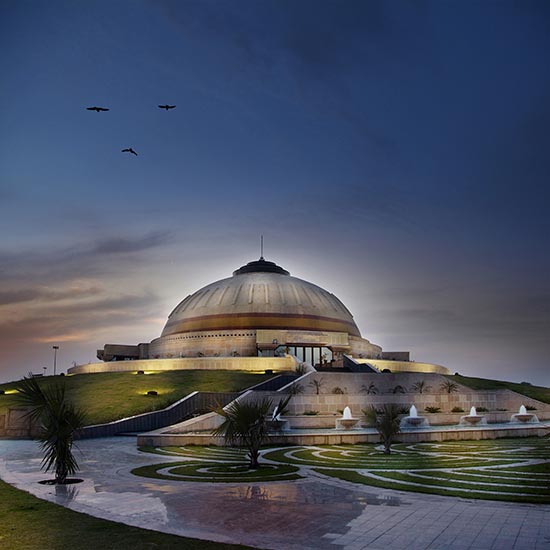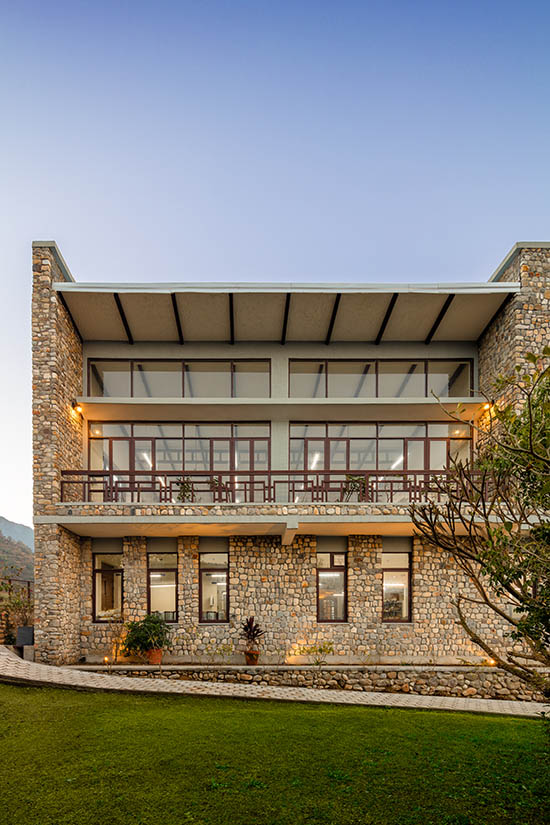
Architectural Group: Architecture BRIO, Mumbai
Principal Designers: Robert Verrijt and Shefali Balwani
Design Team: Robert Verrijt, Shefali Balwani, Sahil Deshpande, Pankaj Chakraborty, Ryan Mcloughlin
Structural Design: Vijay K. Patil Associates
Client: Magic Bus India Foundation
Sponsors: Laureus Foundation
Project Location: Magic Bus Campus, Karjat, Mumbai, India
Project Year (Completion): 2013
Built up Area: 275 sq.m.
Project Type: Institutional, Recreational
Photography: Ariel Huber
The pavilion, designed by Architecture BRIO is located on the Magic Bus Centre for Experiential Learning, situated near Mumbai at the foot of the Western Ghats. Magic Bus is an NGO which seeks to educate and mentor children through outdoor “experiential” learning.
The landscape of the Magic Bus Centre is in stark contrast to the daily living environment of most of Mumbai’s children. While in space-starved Mumbai, outdoor play areas are hard to get by, the Centre is blessed with a unique variety of diverse terrains to be experienced by the children; rivers, woods, nature trails, camping grounds, and expansive green lawns for soccer. All of which is intended to promote the NGO’s concept of “learning by doing”.
Realizing that children in the city are the worst affected by the scarcity of space, Matthew Space founded Magic Bus in 1999. On weekends and evenings he began inviting street kids living at the bus stand across from his office to hop the fence so he could coach them in rugby. Within a few months of his coaching and mentoring, these boys learned discipline, improved self-esteem, hygiene, and understood the importance of respecting team members and opponents in a healthy competitive environment. For many children burdened by the demands of poverty, the sport sessions provided an opportunity to express themselves, release their pent-up energy and be a part of the larger community.
After undertaking successful trips taking groups of kids on weekend camps in the valleys and mountains surrounding Mumbai, the idea of a permanent outdoor campus outside of the city was born.
The first Phase of this project comprising of children’s dormitories, a dining pavilion, volunteers accommodation and a resources centre was designed by Rahul Mehrotra Associates. A challenge course with climbing walls, Jacob’s ladders and zip lines completed the first phase. Architecture BRIO was asked to design the second phase of the project, which included proposals for staff accommodation, a facilitation center for corporates and the Laureus Learning Pavilion.
While a learning pavilion on an outdoor campus for underprivileged children is a very specific program, the pavilion needs to be able accommodate a wide variety of activities such as team building workshops, games, briefing sessions, group discussions, craft classes, raft building and climbing.
Architecture BRIO located the Learning Pavilion on a confluence of four important landscape elements: a seasonal stream turns around a hillock and culminates in a river while flanging an existing soccer field. These elements are emphasized by strategically placing the various activities of the Learning Pavilion on either side of the banks of the stream.
The challenge course on the Magic Bus Centre is extended into the pavilion turning it into an architectural route and binding the landscape, the pavilion, activities and experiences together. Access and circulation to the two decks on the upper floor of the pavilion is provided through the hilled topography as well as wooden climbing ladders.
From the soccer field a log bridge placed on excavated rocks leads you over the stream to the hillock. A series of steps up the hill ends on a cement floored children’s game area which becomes a viewing platform of the sports field during the soccer matches played here. Tucked away below this deck inside the hill are the toilet facilities for the pavilion. A 29 meter long plexiglass roof stretches out covering a second deck and a large double height workshop space. This airy, double height space will be used to play games, build rafts, use the mini Jacob’s ladder or just sit in the shade.
The cantilevered timber deck across the stream is connected with a custom made timber / steel ropes bridge. The bouncy ropes bridge obstacle course makes the otherwise conventional passage from one activity space to another an exciting event. It also becomes a viewing gallery, from which to instruct and cheer climbers using the Jacob’s ladder.
Below the timber deck a watersports store room with kayaks and canoes is enclosed by a series of steel mesh double doors. This deck projects out over the sports field and becomes a viewing platform of the surrounding trees. Two wooden climbing ladders take the children down to the granite stone paved ground floor.
The lightweight structure of the pavilion consisting of dark green painted steel columns and a semi-transparent roof allows it to disappear in the background. As the budget for the project was considerably low, the structure is designed such that it uses the least amount of materials with the maximum amount of covered, shaded spaces. The space below the roof is open to all sides. In the summer months the shade of the roof creates a respite from the heat while natural breeze flowing from the river cools the covered spaces. During the monsoon months the pavilion becomes a dry space to take cover from heavy rains.
Keeping in mind the nature of the Magic Bus Campus as a centre for outdoor experiential learning and sport for development, where children engage with obstacle courses, Architecture BRIO designed the Learning Pavilion as an interactive building becoming part of this Challenge Course.
[quote]Encouraging children to find their own path up down and across the pavilion through various ways, it challenges them to overcome boundaries.[/quote] [quote]It integrates sport and activity as an integral part of the architecture, bringing to life magic bus’s philosophy of social change through sport.[/quote]As the budget for the project was considerably low, the structure is designed such that it uses the least amount of materials with the maximum amount of covered, shaded spaces. This is accomplished through the use of steel columns and a lightweight roof, allowing the structure to remain open from all sides, par the toilets and storage areas which provide support to the two deck areas. This open structure creates a comfortable environment since the natural breeze flowing from the river will cool the covered spaces, and it allows the river to be experienced through the building from the sports field.
Access and circulation to the two decks on the upper floor is provided through the hilled topography, river access, as well as wooden climbing ladders. A custom made ropes bridge suspended from the roof spans accross the two decks, making the pavilion a continuation of the challenge course at the Magic Bus Centre. The airy, double height spaces will be used as an activity zone to play games, watch soccer matches, build rafts, or just enjoy the shade.
[author][author_image]http://www.howarchitectworks.com/wp-content/uploads/2014/02/Robert_Verrijt.jpg[/author_image] [author_info]Architecture BRIO is actively engaged in the creation of contextually appropriate solutions within an increasingly changing world. Set up in Mumbai in April 2006, it is a design-based practice focusing primarily on the fields of Architecture and Interior Design. Its principals are Robert Verrijt (TUDelft, the Netherlands) and Shefali Balwani (C.E.P.T, India). [/author_info] [/author]


























